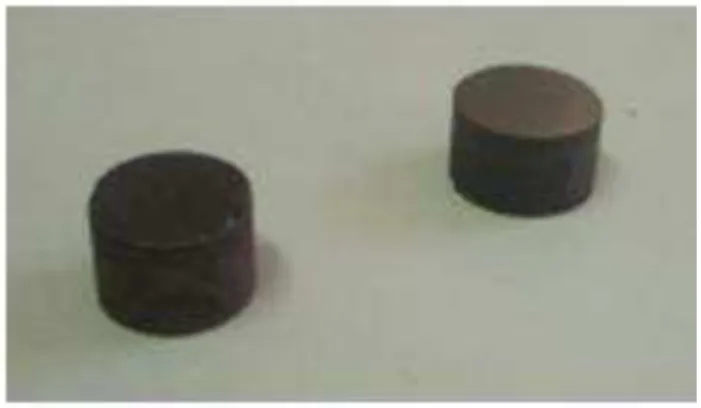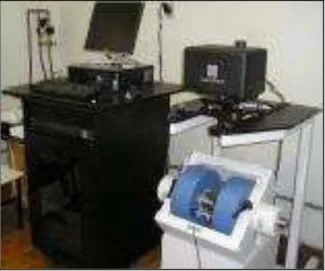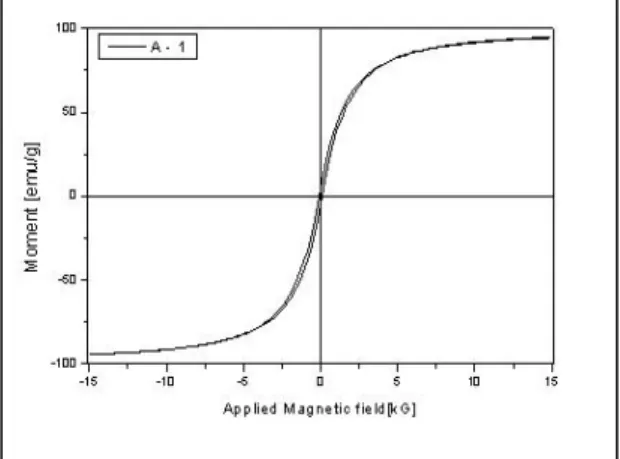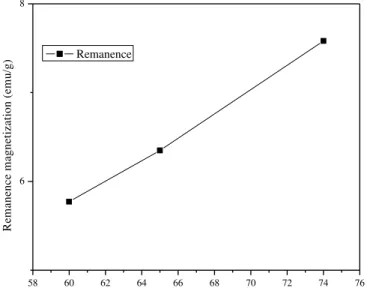ISSN 1517-7076 http://www.materia.coppe.ufrj.br/sarra/artigos/artigo11241 Revista Matéria, v. 15, n. 2, pp. 371-379, 2010.
Characterization and exploitation of piston ring chips in the rectification
process a new recycling proposal
A. TeixeiraI; J. C. DiasI; E. M. da SilvaI; M. R. da SilvaI; M. R. F. GontijoII I Federal University of Itajubá – UNIFEI
e-mail: HUmarcelorobert@unifei.edu.brU
II Tecnological Institute of Aeronautic – ITA
e-mail: mrobert@ieav.cta.br
ABSTRACT
The rough grind machine operation in metallic material produce a sub product with the followings components such as: metallic residue, small parts come from the resin grinds, diatomaceous earth material (filter material) and soluble oil in water for tools cooling. According [HU1UH] from ABNT, this sub product is
toxic, not inert material, aggress the environment with pollution in the currency water and contaminate the ground when incorrectly go to the municipal solid waste. The final destination of this sub product, is the incineration, in the cements company, being the incorporated the sub product to the cement, during your production.
With the qualitative result using the scanning electron microscopy (SEM), coupled to the dispersive energy spectroscopy (EDS), two experiments were made with objective to separate the magnetic material of the non-magnetic material, using a permanent magnet. We conclude that the magnetic material can be used by powder metallurgy process in production of pieces.
Keywords: Metallic residue, grinding machining process, recycling material.
1 0BINTRODUCTION
The increasing worldwide industrial activity and the absence of efficient programs in the management of this residue make with more and more residues are generated without a correct use or disposal of these, providing ambient liabilities that compromise the quality of life in the future generations. A good part of these residues is dangerous and contains elements that can harm the health human being, as well as contaminating the underground and the currency water.
While in a past not very distant, the production of residues was of some sets on ten of kg/hab.year, countries highly industrialized, as the United States, produce currently more than 700 kg/hab.year.
In Brazil, the average value in some cities most populous is in order of 180 kg/hab.year [HU2UH].
The concern with the industrial recycling has taken the industries to search alternatives for final disposal of its residues being a reasonable exit the use of processes adjusted for its recovery.
Amongst these processes it is distinguished powder metallurgy, which is a metallurgic process of manufacture of metallic parts, not metallic and ceramic that comes developing in taxes each more increasing nowadays. This process distinguished from the conventional process because has the liquid phase absence or only a partial presence of liquid phase during the processing [HU3UH, HU4UH].
Thus one, is a kind of a manufacture technique that is possible the production of parts with definitive or practically definitive forms and dimensional tolerances very short and is possible the production of components with certain structural and physical characteristics impossible to be gotten through any another metallurgic process [HU5UH].
Some aspects associates to the study of the recycling of solid residues industries have been published in recent literature [HU6UH-HU8UH] and many of these studies also detach the importance of the recycling in
the reduction of the ambient impact and in the increase of the industrial productivity.
material (filter material) and soluble oil, in ratio of 5% dissolved in water, for tools cooling. According [HU1UH],
this sub product is toxic, not inert material, aggress the environment with pollution in the water currency and contaminate the ground when incorrectly go to the municipal solid waste. The final destination of th i s s u b p r od u ct , is the in cin er at i on , in th e cem en t s c o m p a n y, bei n g th e incorporated the sub product to the cement, during your production. The generation of this solid residue is about of 200T/month and the total cost to send to the cements company is near of US$ 100/T.
In this direction, this work has for objective, the recycling of the sub product in a more efficient and productive form. Therefore what today it is a dejection, whose final destination has a financial responsibility for the industries, with the recycling, starts to have a useful destination, that is, becomes to be a raw material for the manufacture of parts and adding value to the final product.
2 1BMATERIALS AND METHODS
Initially, had been collected manually eight samples of the residues from the rough grind rectification process for the following irons materials: gray cast iron, ductile iron and martensitic iron. In the total, have 17 types different chemical composition and don’t have separation of these leagues, in the process. It became the characterization of the same ones through the scanning electron microcopy (SEM), model JSM-6510LV, manufacturer JEOL, coupled to the energy dispersive spectroscopy (EDS), using the tungsten radiation.
With the qualitative results from SEM and EDS, two experiments are made. The first one is: were collected 100g of the sub product and put into the electric furnace until the temperature of 600°C, during 10min. and the electric furnace was disconnect. A permanent magnet was passed and removed 92.8g of magnetic material and was separate 7.2g of non-magnetic material. In the second experiment, were collected 100g of the sub product and put into a Berzelius Becker, with a 30g of NaOH and completed until 500ml with distillated water, was agitated per 10min and decant per 24hours. After this, the solution was filtered and the filter paper was calcinated per 2 hours at 1000ºC and small parts didn't adhere to the permanent magnet. The decanted material was drying at 120°C per 2 hours and a permanent magnet was passed and removed 93.5g of magnetic material and 6.5g of non-magnetic material. The material that adhered to the permanent magnet passed for a process of grain sized classification, through vibratory nets mark Granutest and was separated in meshes 60, 65 and 74μm. After this the powder was compact using a manual hydraulical press, mark Marconi, whose pressure of compacting was of 432MPa.
After compacting, the sintering was initiated in the bodies of tests in an electrical furnace, to a temperature of 800°C, being that the same ones had remained in this temperature for 8h, after this, the electrical furnace was disconnected, being with the closed door, cooling slowly until the room temperature, without insufflations of inert gases, in your atmosphere, during the sintering process Figure 1.
Figure 1: Tester`s Bodies Sinterezed.
The Figures 2 and 3 represents the tester’s body with grain size 74μm sinterezed and after this, was made its micrograph polished with Al2O3 and etched with 4% nital reagent, shown below with magnification
Figure 2: Etching nital 4%; magnification 160x.
Figure 3: Etching nital 4%; magnification 800x.
After sintering the test bodies, a small sample were removed, was take its dimensions and had been weighed in the scale mark Bel Engineering of 210g with precision of 0.001g and identified. After this identification the test bodies had been taken to the magnetometer of vibrant sample (VSM). The magnetic behavior of the samples was investigated through the hysteresis loops (M-H) with temperature of 28 °C, using the equipment Magnetometer (VSM), mark Lake Shore, model 7410 with variation in the scales of measures from 1x10-7emu until 1000emu, Figure 4.
3 2BRESULTS AND DISCUSSION
3.1 6BPhysical – Chemical Analysis of the Residues
It is fundamental a study of the physical-chemical characteristics of the residues properties, done through appropriate methods. Such information will give subsidies for the selection and if is possible, the residues applications. The comprehension of process that generated the residue, supplies good information to the conception of a recycling strategy as use viability in the commercial market. Due to the presented considerations, 8 samples of the sub product was collected, identified and later analyzed in the tech center of Mahle Industries. The results of the sub product constitutions was obtained through scanning electron microscopy (SEM) coupled to dispersive energy spectroscopy (EDS), for the following chemical elements: C, O, Fe, Cr, Mo, K, Si, Na, Mg, Ca, Al, Ti and Mn.
Through the analysis using the SEM, coupled with the EDS in the sample 1, Figure 5a, observes high amount of oxygen, probably this chemical element is proceeding from the oxidation of the material through the soluble oil in water. Also notices the presence of other chemical elements such as iron and aluminum. The iron from the metallic basic material and the aluminum comes from the aluminum oxides grinds. In Figure 5b, sample 2, notices one high amount of iron and silicon, proceeding from the metallic basic material in study, also observes the presence of oxygen and aluminum in lesser ratios.
(a) (b)
Figure 5: (a)Sample 1 and (b) sample 2.
When observing the EDS of Figure 7a, sample 5, it is noticed higher presence of the oxygen, iron and silicon. Probably the oxygen comes from the oxidation of the soluble oil in water, already the iron and the silicon comes from the metallic basic material in study. However, in the Figure 7b, sample 6, observe silicon as chemical element of prominence, followed of the oxygen and other elements in lesser ratios.
(a) (b)
Figure 7: (a) Sample 5 and (b) sample 6.
Through scanning electron microscopy analysis in the sample 7, Figure 8a, it is noticed presence in prominence of the chemical element silicon followed of the oxygen, being that the silicon comes from the metallic basic material and the oxygen from the oxidation of the soluble oil in water.
To the step in the Figure 8b, sample 8, the chemical element in prominence is the aluminum followed of the oxygen. Thus it is perceived that in each analysis of the samples a chemical element appears in excessively prominence than others, this having to some metallic leagues that are passing for the rectification process.
(a) (b)
Figure 8: (a) Sample 7 and (b) sample 8.
In order to obtain the quantitative values of the magnetic materials that adhered in the permanent magnet, that is, 92.8g in the first experiment and 93.5g in the second experiment. It was made chemistry analysis, using the following methods: combustion by equipment name Leco for the chemical elements carbon and sulfur. For the chemical element silicon, the gravimeter method was used and for the chemical element manganese, was used the colorimetric method. The following results were obtained of the chemical analysis, according to Table 1.
Table 1: Chemical analysis.
Chemical elements (%) Experiments Types of methods
Experiment 1 Experiment 2
C 2.73 2,65 Combustion, Leco
S 0.023 0.006 Combustion, Leco
Si 2.65 2.72 Gravimeter
Mn 0.43 0.52 Colorimetric
Fe and others alloys elements
(Difference) 94.51 94.73 __________
3.2 7BMagnetic Characterization
According to [HU9UH] the magnetic parameters such as, coercive field (HC) induction remained (MR) and
magnetic saturation (Ms) had been determined through the hysteresis loops MxH. The magnetic susceptibility
was calculated using the formula =dM/dH, determined by the derivative of the MxH curve, in the region where the irreversible displacement occurs.
The product of the maximum energy can be calculated by the inductive demagnetization curve (MxH) max of the material, being that this product of the maximum energy represents the energy spends to
magnetize and to demagnetize a magnetic material [HU10UH]. The dependences of the magnetization (B) in the
applied field (H) for the samples of the systems had been analyzed through the magnetic hysteresis loop that is represented in Figures 9, 10 and 11.
Figure 11:Hysteresis loops, grain size 74μm.
The intermediary areas presented in the hysteresis loops, it is observed that the material still presents characteristics of a soft magnetic material [HU11UH, HU12UH and HU13UH], like showed in the Table 2.
Table 2: Results gotten in the different grain size of powder.
Amostra Hc (G) Mr (emu/g) Ms (meu/g)
A-1 118.1533 5.7714 84.0400
B-1 106.3380 6.3486 88.5571
C-1 88.6150 7.5824 104.6819
As the magnetic properties of magnetization and permeability are dependents of the movement of the wall of its domain, is observed in the Figure 12, that when increasing the grain size, the magnetic saturation MS increase too. The Figure 13, shown the relationship between the grain sizes in function of the
induction remained MR and is observed that when increasing the grain size, the induction remained MR
increase too.
Figure 12: Influence of grain size on the magnetic saturation (Ms).
58 60 62 64 66 68 70 72 74 76
82 84 86 88 90 92 94 96 98 100 102 104 106
M
ag
ne
ti
za
ti
on
(
e
m
u/
g)
Figure 13: Influence of grain size on the induction remained (Mr).
4 3BCONCLUSIONS
This study demonstrated that the characterization of the residues through the scanning electron microscopy (SEM), coupled to the energy dispersive spectroscopy (EDS), using the tungsten radiation, showed to be a good option to make a qualitative analysis of the samples in study. However, the small parts that didn't adhered to the permanent magnet, the same one could be mixed in the cement mortar, for the production of concrete blocks and to be used in the building construction, or they will have a final destination to the municipal solid waste, because now, they passed to don’t attack the environment, they take care of the questions of ABNT-NBR 10.004, changed the residue classification from Classroom I and Classroom II, to Classroom I and Classroom III, that is, toxics and inert material.
The gotten hysteresis loops, for the three different grain size had presented small variations, therefore, we can conclude with these results to be about a magnetic soft material, being thus, it is possible to direct for a specific applications, such as, the core of power supplier station or in rotation electric engines.
5 4BACKNOWLEDGEMENT
PRPPG/UNIFEI, Capes and Mahle Group.
6 5BREFERENCES
[1] ABNT NBR10004, Resíduos sólidos – Classificação, 2˚ed.,71p, 2004.
[2] RIBEIRO, D.V., TACHARD, A.L.R., MORELLI, M.D., “Influência da adição do pó de retífica em uma matriz de fosfato de magnésio -Parte II”, In: Congresso Brasileiro de Engenharia e Ciência dos Materiais- 17º CBECIMat, pp.1-12, 2006.
[3] GHADIRI M., FARHADPOUR, F.A., CLIFT R., SEVILLE, J.P.K., “Particle characterization size and morphology”, The Institute of Metals Series on Powder Metallurgy an Overview, London, pp.56-75, 1991.
[4] CHIAVERINI, V., Aços e Ferros Fundidos, ABM, 7˚ Ed., São Paulo, Brasil, pp. 583, 2005.
[5] STADTLER, W.A., “Production of Metallurgy Parts”, ASTM, Powder Metallurgy, Ohio, pp.449-463, 1989.
58 60 62 64 66 68 70 72 74 76
6 8 R em an en ce m ag ne ti za ti on ( em u/ g)
[7] DAS, B., PRAKASH, S., REDDY, P.S.R., MISRA, V.N., “An overview of utilization of slag and sludge from steel industries”, Resources Conservation & Recycling , pp. 40-57, 2006.
[8] Fundação Estadual do Meio Ambiente- FEAM, 2009, “Resultado do Inventário Estadual de Resíduos Sólidos Industriais e Minerários do Estado de Minas Gerais”, Ano Base 2008.
[9] GONTIJO, F.R.M., “investigação das propriedades elétricas e magnéticas no composto BaNbXFe2-XO4”,
Dissertação de M.Sc., Universidade Federal de Itajubá-UNIFEI, pp. 104p, 2007.
[10] SILVA, M.R., “Materiais magnéticos e ferroelétricos modificados”. Tese de Doutorado, Universidade Federal do Rio de Janeiro - UFRJ, pp. 104, 1998.
[11] PENNANDER, L., JACK, A., “Soft magnetic iron powder material AC properties and their application in electrical machines”, Magnetic Materials, Euro PM (2003).
[12] CULLITY, B.D., GRAHAM, C.D., “Introduction to Magnetic Material”, John Wiley & Sons, 2˚ ed., pp. 487, 2009.




